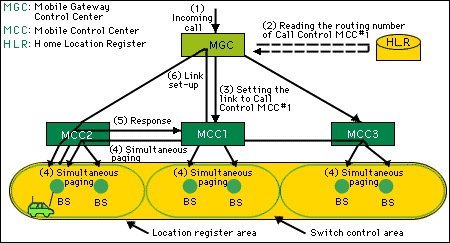Mobile Communications Network -2.Characteristic Network Control Technology
When the number of mobile units increases, multiple subscriber mobile communications control stations (or "MCCs") become necessary in a single location registration area. In response to a call termination signal from another network, the relevant mobile gateway communications control station ("MGC") establishes a line to the call control MCC in accordance with the call control MCC's routing number acquired from the home location register. The call control MCC simultaneously calls the mobile unit through the other MCCs in the same location registration area. This is known as "multiple MCC simultaneous call control."
The call control MCC connects the subscriber line to the relevant MCC after receiving a response, and the connection is made to the mobile unit. Even if the mobile unit moves during the call, the call control MCC established at the time of call origination/termination continues to carry out control. This system is called "subscriber line extension call control."
In case no idle radio channels are available in the cell where the mobile unit is located and the mobile unit is in the marginal territory of multiple cells, connection quality can be improved by utilizing an idle channel in an adjacent cell. The MCC which first received the call origination signal serves as the call control MCC, and confirms the availability of idle channels with the MCC controlling an adjacent cell. If an idle channel in an adjacent cell is selected, the subscriber line is extended to the MCC that controls the relevant cell.

Multiple MCC Simultaneous Paging
![]() Created 1999/03
Created 1999/03



